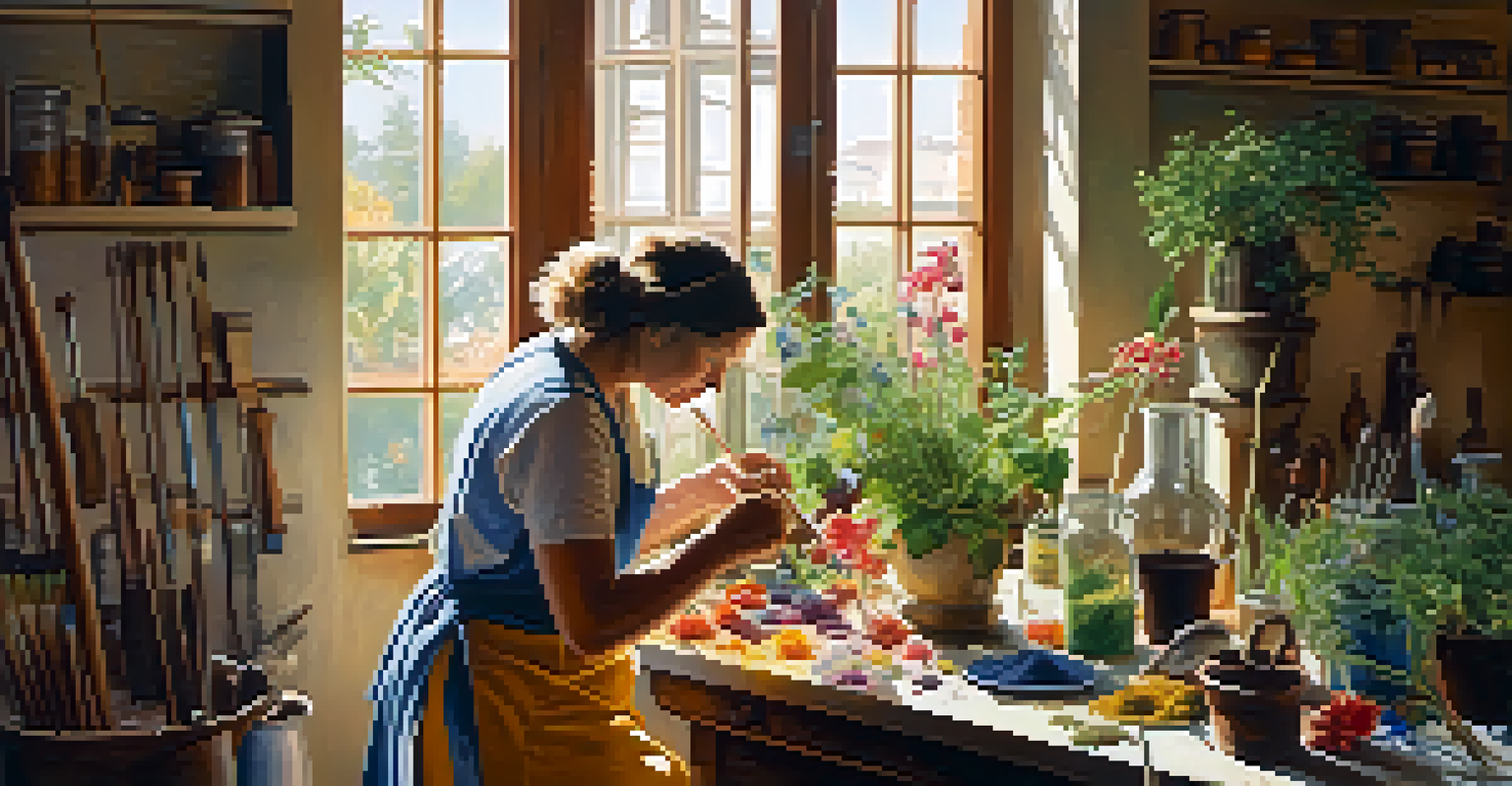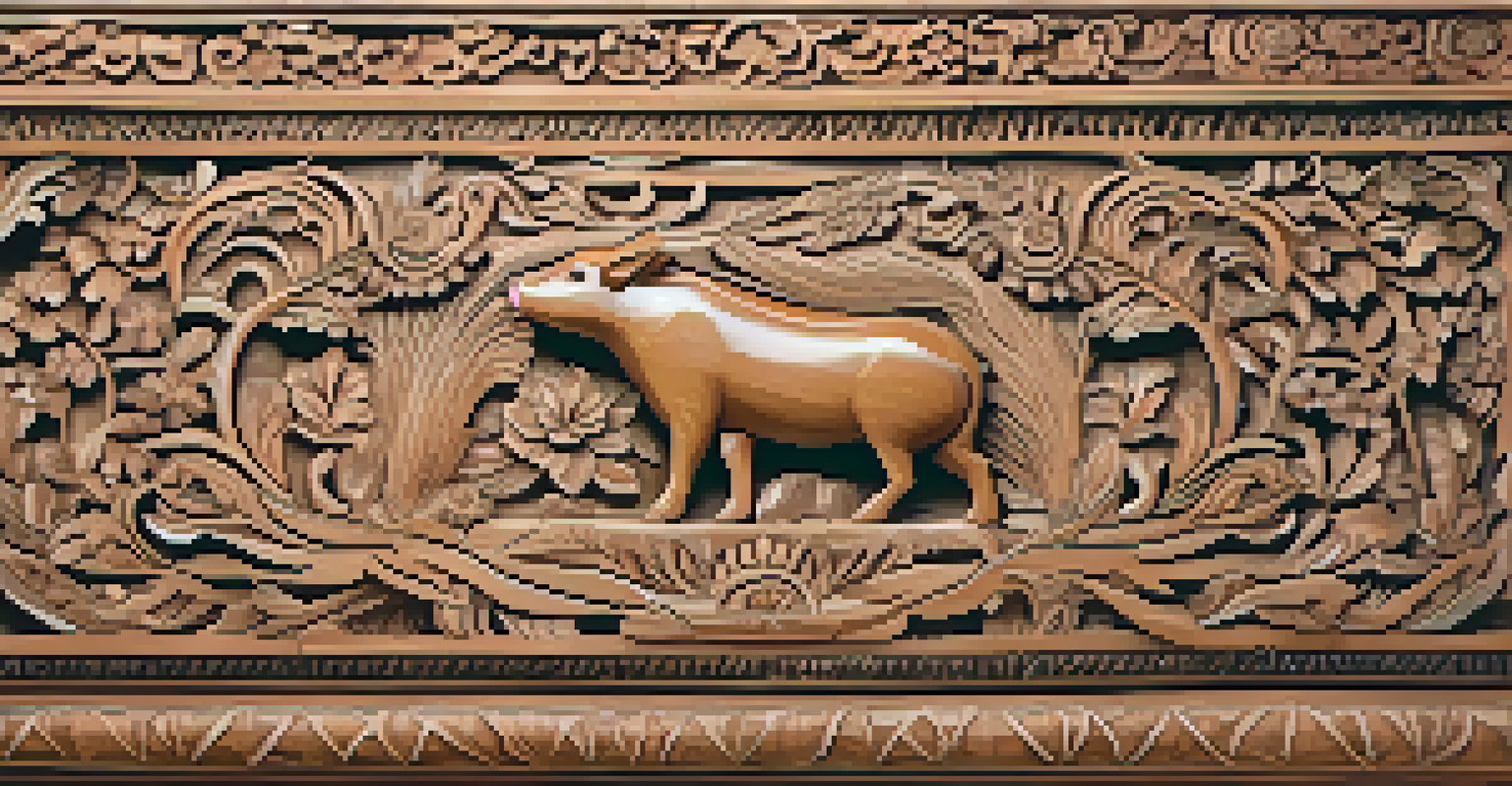Nature's Colors: Using Natural Pigments in Carving Art

Understanding Natural Pigments and Their Origins
Natural pigments have been used for centuries, deriving from plants, minerals, and even insects. These pigments are the colors we see in nature, like the rich reds of clay or the vibrant greens of leaves. Artists have tapped into this palette to create works that resonate with the environment. By understanding where these colors come from, we can appreciate their beauty and significance in our carvings.
Art is not freedom from discipline, but disciplined freedom.
For instance, ochre, a naturally occurring clay pigment, has been used since prehistoric times. It not only provides a beautiful range of yellows and reds but also connects us to ancient art forms. Similarly, the vibrant blue from lapis lazuli has captivated artists for ages, showcasing how nature’s bounty can inspire creativity. Knowing these origins allows artists to cultivate a deeper connection with their materials.
As we delve into the world of natural pigments, it's essential to recognize the sustainable practices associated with their use. Harvesting pigments from the earth often involves minimal environmental impact, making it a responsible choice for artists who care about the planet. This connection to nature not only enriches the artwork but also promotes a harmonious relationship with our surroundings.
The Benefits of Using Natural Pigments in Art
Using natural pigments offers artists a multitude of benefits, both aesthetic and ethical. One of the most significant advantages is the unique, organic quality they bring to artwork. Unlike synthetic colors, natural pigments can create subtle variations that give depth and character to carvings. This uniqueness can evoke a sense of authenticity that resonates with the viewer.

Moreover, many natural pigments are non-toxic and safer for artists to work with compared to their synthetic counterparts. This is especially important for those who spend long hours carving and painting, as it minimizes health risks. When artists choose natural pigments, they are not just making a choice for their art; they are making a choice for their well-being.
Natural Pigments Connect Art to Nature
Natural pigments derived from plants, minerals, and insects foster a deeper appreciation for the environment and enhance the artistic process.
In addition to health benefits, using natural pigments fosters a deeper appreciation for the environment. Artists often find inspiration in nature, and by incorporating its colors into their work, they pay homage to the beauty around them. This practice encourages a more mindful approach to art-making, highlighting the importance of sustainability and respect for natural resources.
Techniques for Extracting Natural Pigments
Extracting natural pigments can be an exciting and rewarding process for artists. Common methods include grinding minerals, pressing plants, or even boiling certain materials to release their colors. For example, turmeric can be boiled to extract a vibrant yellow dye, while charcoal can be ground to create a deep black pigment. Each technique varies, offering artists a chance to explore their creativity in new ways.
Nature always wears the colors of the spirit.
Additionally, many artists experiment with different mediums during extraction. For instance, they might mix ground pigments with oils, water, or natural binders to create paints or pastes suitable for carving. This experimentation can lead to unique textures and finishes that enhance the final artwork. It's a fascinating blend of science and artistry that breathes life into the creative process.
It's also important to document the extraction methods and results for future reference. This not only helps in replicating successful techniques but also contributes to a growing body of knowledge about natural pigments. Sharing these methods within the artistic community can inspire others to explore and innovate, further enriching the world of carving art.
Incorporating Natural Pigments into Carving Art
Once natural pigments are extracted, the next step is incorporating them into carving art. This can be done through various techniques such as painting, staining, or even inlaying the pigments directly into the wood or medium. For example, an artist might carve intricate patterns into wood and then fill those grooves with colored natural pigments to create stunning contrasts. This not only enhances the visual appeal but also adds a tactile element to the artwork.
Another method is to create washes or glazes using natural pigments. By diluting pigments with water or oil, artists can achieve a translucent effect that allows the texture of the carving to shine through. This technique is especially effective in wood carving, where the grain can add depth to the color. The interplay between the carved surface and the natural hues can result in breathtaking pieces that tell a story.
Health and Safety in Art Practices
Using non-toxic natural pigments not only benefits the health of artists but also encourages a mindful approach to art-making.
Ultimately, the way natural pigments are used in carving art is limited only by the artist's imagination. Whether through bold strokes or subtle washes, these colors can transform a simple carving into a masterpiece. The process encourages exploration and experimentation, making each piece a unique reflection of the artist's vision and connection to nature.
Showcasing Carvings with Natural Pigments
Once the carvings are complete, showcasing them effectively becomes vital. Displaying artworks that use natural pigments can enhance their appeal, drawing attention to the vibrant colors and textures. Consider using natural materials for frames or stands—this not only complements the artwork but also reinforces the theme of nature. It creates an immersive experience for viewers, inviting them to appreciate the craftsmanship and the materials.
Additionally, sharing the story behind the pigments can add depth to the viewing experience. When artists explain their process of sourcing and using natural pigments, it captivates audiences and fosters a connection between the viewer and the artwork. This storytelling aspect can be integrated into exhibitions, social media posts, or artist talks, making the art not just visual but also narrative.
Furthermore, collaborating with local galleries or community spaces can provide a platform for artists to showcase their work. These venues often appreciate the unique aspect of natural pigments and can help promote an appreciation for sustainable practices in art. By sharing their creations, artists contribute to a broader conversation about the importance of nature in our lives and how it can inspire creativity.
Maintaining the Integrity of Natural Pigments
Caring for artworks made with natural pigments is essential to preserving their beauty over time. Unlike synthetic colors, natural pigments may fade or change with exposure to light and air. Artists can take preventative measures by using archival-quality sealants or varnishes that protect the artwork while allowing it to breathe. This ensures that the vibrant colors remain intact for years to come.
Additionally, storing artworks in a controlled environment can help maintain their integrity. Keeping pieces away from direct sunlight, humidity, and extreme temperatures is crucial. This might involve using protective cases or specific display techniques that minimize exposure to damaging elements. Taking these precautions not only prolongs the life of the artwork but also shows respect for the materials used.
Sustainability in Contemporary Art
The resurgence of natural pigments reflects a growing awareness of sustainability in the art world, inspiring innovative techniques and practices.
It's also beneficial for artists to periodically assess their work and make any necessary touch-ups. This not only keeps the artwork looking fresh but also allows artists to maintain a connection to their earlier creations. Embracing the idea of ongoing care and attention can foster a deeper appreciation for the craftsmanship involved in using natural pigments in carving art.
The Future of Natural Pigments in Art
As the art world continues to evolve, the role of natural pigments is gaining renewed interest. Artists and collectors alike are becoming more aware of the environmental impact of synthetic materials, leading to a resurgence in the use of natural colors. This shift not only emphasizes sustainability but also celebrates the unique qualities that natural pigments offer, creating a vibrant dialogue around their use in contemporary art.
Moreover, educational initiatives are emerging to teach new generations of artists about the benefits and techniques of using natural pigments. Workshops, online courses, and community projects are helping to spread knowledge and inspire creativity. By fostering a passion for natural materials, artists can contribute to a growing movement that values sustainable practices in the creative process.

Looking ahead, the future of natural pigments in carving art is promising. As more artists embrace these materials, we can expect to see innovative techniques and stunning works that showcase the beauty of nature. This journey not only enriches the art community but also encourages a deeper connection between art and the environment, reminding us of the colors that nature provides.